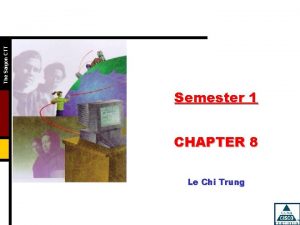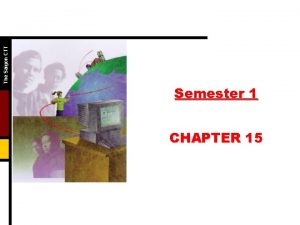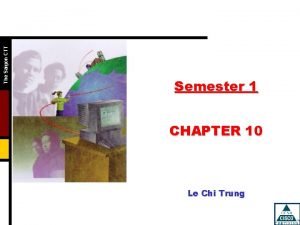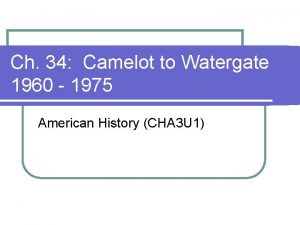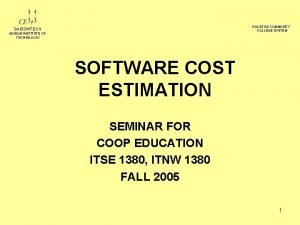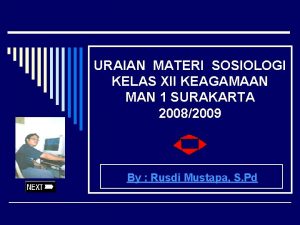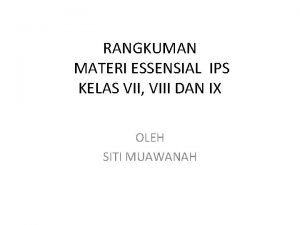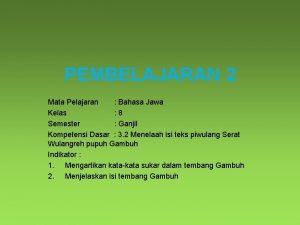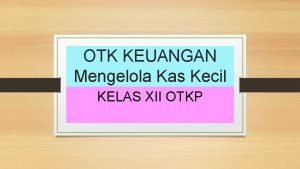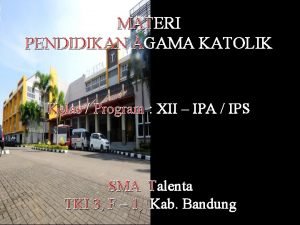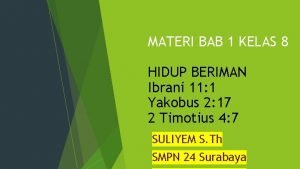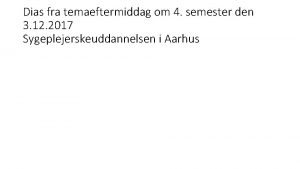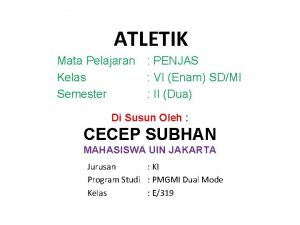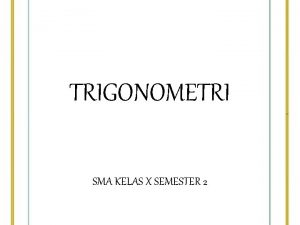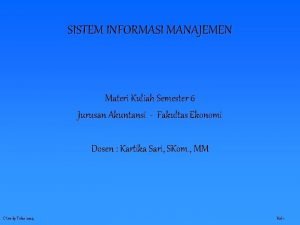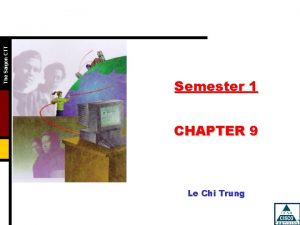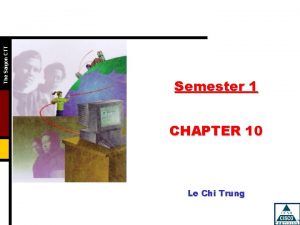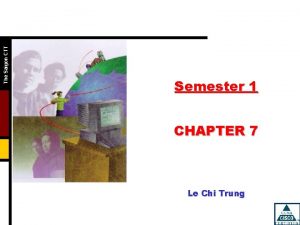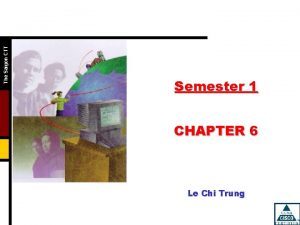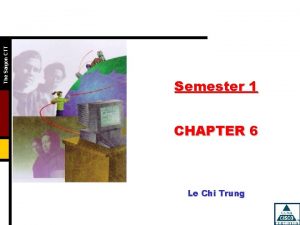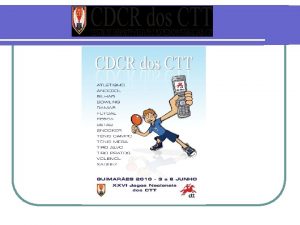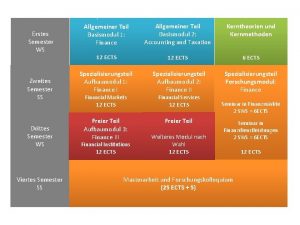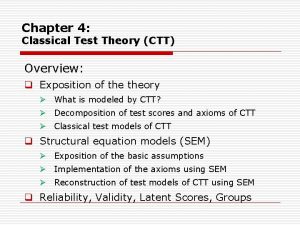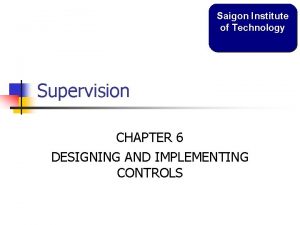The Saigon CTT Semester 1 CHAPTER 7 Le








































































































- Slides: 104

The Saigon CTT Semester 1 CHAPTER 7 Le Chi Trung

The Saigon CTT }Content • Token-ring. • FDDI LAN. • Ethernet and IEEE 802. 3. • Layer 2 devices and effects on data flow.

The Saigon CTT }Schedule Date Lesson No 20 -Aug 22 -Aug 24 -Aug 27 -Aug Name Lab Est time No Name Est Time Chapter 6 Online Exam 7. 1 The basics of token ring 0: 30: 00 7. 2 The basics of FDDI 0: 30: 00 7. 3 The details of Ethernet and IEEE 802. 3 1: 00 7. 4 Layer 2 devices 0: 30: 00 7. 5 Effects of layer 2 devices on data flow 0: 30: 00 7. 6 Basic of Ethernet 10 Base-T troubleshooting Chapter 7 Online Exam 7. 6. 2 Network discovery 0: 30: 00 7. 6. 3 Network discovery 0: 30: 00 7. 6. 4 Protocol inspector Frame Stats 1: 00

The Saigon CTT BASIC OF TOKEN-RING

The Saigon CTT }Variants IBM developed the first Token Ring network in the 1970 s. It is still IBM's primary LAN technology, and is second only to Ethernet (IEEE 802. 3) in terms of LAN implementation.

The Saigon CTT }Ring topology

The Saigon CTT }Data passing • When a station has information to transmit, it seizes the token and sends data frame to the next station. • When frame reaches the destination station, the data is copied for processing. • Frame continues to circle the ring until it returns to the sending station. • Sending station removes the frame from the ring, verifies receipt, and releases the token.

The Saigon CTT }Token-Ring frame format

The Saigon CTT }Start delimiter and End delimiter • Start delimiter. – Alert for the arrival of a token. – Includes an identification symbol. – Violates encoding system to differentiate from other frame fields. • End Delimiter – Completes the token or data/command frame. – Contains damage indicator. – Last of logical sequence.

The Saigon CTT }Access control P P P T M R R R • P: Priority bits • T: Token bit • M: Monitor bit • R: Reservation bits

The Saigon CTT }Priority and reservation bits • B'000' Normal User Priority • B'001' Normal User Priority • B'010' Normal User Priority • B'011' Normal User priority • B'100' Bridge/Router • B'101' Reserved IBM • B'110' Reserved IBM • B'111' Station Management

The Saigon CTT }Priority management • Using the priority field and the reservation field. • Stations with a higher priority can reserve the token for the next network pass. • Stations that raise a token's priority level must reinstate the previous priority after their transmission has been completed.

The Saigon CTT }Frame control • Only present in data/command frames. • Indicates whether frame contains data or control information. • If control, this byte specifies type of control information.

The Saigon CTT }Destination and Source addresses • • Universal Address. Local Administered Address. Broadcast Address (D). Functional Address (0 x 0 C 0000 00 XXXX) (D).

The Saigon CTT }Data • Length limited by the maximum time a station may hold the token.

The Saigon CTT }Frame checksum • Frame Check Sequence. • Source fills field with calculated value dependent on frame contents. • Destination recalculates to check data integrity. • Frame is discarded if damaged.

The Saigon CTT }Frame status • Address recognized / frame copied indicator.

The Saigon CTT }Management mechanisms • Active Monitor – One station acts as centralized source of timing information for other stations. – Removes continuously circulating frames by set monitor bit to 1. – Start a token, when token have been lost. • Beaconing – Detects and repairs network faults. – Initiates auto-reconfiguration.

The Saigon CTT }Encoding: Differential Manchester

The Saigon CTT }Physical topology • Physical topology : Star. • Logical topology : Ring. • IBM Token Ring network stations are connected to MSAU (Multi-Station Access Unit). • Many MSAU can be wired together to form one large ring.

The Saigon CTT }Multi-MSAU

The Saigon CTT }Physical connection

The Saigon CTT }Review • Operation of Token-Ring. • Token-Ring frame structure. • Encoding and topology.

BASIC OF FDDI The Saigon CTT

The Saigon CTT }Characteristics • Fiber Distributed Data Interface. • FDDI is popular as a campus backbone technology. 4100 Mbps 4 Token passing 4 Dual-ring 4 Fiber Optic Cable 4 Total fiber length of 200 Km 4 Station distances up to 2 Km

The Saigon CTT }FDDI dual-ring (PR and SR)

The Saigon CTT }FDDI Media • Fiber Optic – Single-mode, Laser (< 40 Km) – Multi-mode, LED (< 2 Km) – Multi-mode low cost, LED (< 500 m) • Twisted Pair Copper – UTP, STP (< 100 m) - CDDI

The Saigon CTT }Fiber-optic modes

The Saigon CTT }FDDI Connections • Class A: connect directly with PR – SR. – DAC: Dual Attachment Concentrator – DAS: Dual Attachment Station • Class B: connect via FDDI concentrator. – SAS: Single Attachment Station

The Saigon CTT }Attachments

The Saigon CTT }FDDI standard: ANSI X 3 T 9. 5

The Saigon CTT }Physical Layer Medium (PMD) • Physical Medium Dependent: How a station physically connect to a FDDI ring? • Defines the characteristics of the transmission medium: – Fiber optic link – Power levels – Bit error rates – Optical components – Connectors

The Saigon CTT }Physical Layer Protocol (PHY) • PHysical la. Yer protocol: How the signals are transmitted around the FDDI ring? • Part of the physical layer that are media independent. • Defines data encoding/decoding procedures: – Framing – Clocking requirements – Other functions (Link state…)

The Saigon CTT }Media Access Control (MAC) • Media Access Control: How the physical medium is accessed on FDDI ring? • Construction, transmission, receiving, and removal of frames and tokens. • Defines how the medium is accessed: – Frame format – Token handling – Addressing – Error recovery mechanisms

The Saigon CTT }Station Management (SMT) • Defines the FDDI station configuration, enables stations to work together within the ring : – Ring configuration – Initialization – Station insertion and removal – Fault isolation and recovery – Scheduling – Collection of statistics

The Saigon CTT }Types of traffic • Synchronous traffic can consume a portion of the 100 Mbps total bandwidth of an FDDI network, while asynchronous traffic can consume the rest. • Synchronous Mode: – Allocated parts of the bandwidth to one or more workstations. – Predictable response time. • Asynchronous Mode: – Priority scheme.

The Saigon CTT }FDDI frame format

The Saigon CTT }Preamble, Start and End delimiter • Preamble. – Prepares for the upcoming frame • Start delimiter. – Alert for the arrival of a token. – Differentiate from other frame fields. • End Delimiter – Completes the frame. – Contains damage indicator.

The Saigon CTT }Frame control • The size of the address fields • Other control information • Asynchronous or Synchronous data

The Saigon CTT }Source and destination addresses • • Addresses are 6 bytes Unicast Multicast (D) Broadcast (D)

The Saigon CTT }Data • Control information, or information destined for an upper-layer protocol

The Saigon CTT }FCS • Cyclic redundancy check (CRC). • For error control

The Saigon CTT }Frame status • Allows the source station to determine if an error occurred and if the frame was recognized and copied by a receiving station

The Saigon CTT }Operation mechanisms • Connection Establishment – Station connect to neighbors to form the ring. – Negotiate the length of the link. • Ring Initialization – Station claim the right to generate a token. • Steady-state Operation – Token passing • Ring Maintenance – Detects and repairs token or network faults.

The Saigon CTT }Encoding: 4 B/5 B

The Saigon CTT }FDDI topology

The Saigon CTT }Review • Operation of FDDI. • FDDI frame structure. • Encoding and topology.

The Saigon CTT ETHERNET AND IEEE 802. 3

The Saigon CTT }Ethernet introduction • Ethernet is the most widely used local area network (LAN) technology. • Ethernet was designed to carry data at high speeds for very limited distances. • Ethernet is well suited to applications where a local communication medium must carry sporadic, occasionally heavy traffic at high peak data rates.

The Saigon CTT }Ethernet history • 1960 s, the University of Hawaii. • 1970 s, Xerox developed the first system. • 1980, IEEE released 802. 3 specification. • 1980 s, Digital, Intel and Xerox jointly developed and released an Ethernet specification (v 2. 0), Compatible with 802. 3 • Today, the term Ethernet is often used to refer to Ethernet specifications, including IEEE 802. 3.

The Saigon CTT }Datalink and Physical layers

The Saigon CTT }Comparing Ethernet and IEEE 802. 3 • Specify similar technologies. • Broadcast network. • Using CSMA/CD algorithm. • Hardware implementation. • Differences: – Ethernet provides services corresponding to physical and datalink layer. – IEEE 802. 3 specifies the physical layer and the channel-access portion of the data link layer but does not define a LLC protocol.

The Saigon CTT }Ethernet family: 1000 Base-SX-LX

The Saigon CTT }Ethernet family: 1000 Base-T

The Saigon CTT }Ethernet family: 100 Base-TX

The Saigon CTT }Ethernet family: 10 Base-T

The Saigon CTT }Ethernet family

The Saigon CTT }Ethernet frame format

The Saigon CTT }Preamble • Note that a frame is Ethernet or IEEE 802. 3.

The Saigon CTT }Start of frame delimiter (SOF) • The IEEE 802. 3: synchronize the frame-reception portions of all stations on the LAN. • Be explicitly specified in Ethernet.

The Saigon CTT }Source and destination addresses • • MAC addresses. Unicast. Multicast (D) Broadcast (D)

The Saigon CTT }Type (Ethernet) • Specifies the upper-layer protocol to receive the data after Ethernet processing is completed

The Saigon CTT }Length (IEEE 802. 3) • The length indicates the number of bytes of data that follows this field

The Saigon CTT }Data (Ethernet) • the data contained in the frame is sent to an upper-layer protocol

The Saigon CTT }Data (IEEE 802. 3) • Data send to LLC layer, including LLC header and upper-layer data

The Saigon CTT }Frame check sequence (FCS) • This sequence contains a 4 byte CRC value that is created by the sender and is recalculated by the receiver to check for damaged frames

The Saigon CTT }Media Access Control (MAC) • Shared-media broadcast technology. • Ethernet’s MAC performs three functions: 1. transmitting and receiving data packets 2. decoding data packets and checking them for valid addresses before passing them to the upper layers of the OSI model 3. detecting errors within data packets or on the network

The Saigon CTT }Broadcast technology M C A

The Saigon CTT }Broadcast address FF-FF-FF-FF

The Saigon CTT }CSMA/CD • When a station wishes to transmit, it checks the network to determine whether another station is transmitting. • If network is free, the station proceeds with the transmission. • While sending, the station monitors the network to ensure that no other station is transmitting. • If a transmitting node recognizes a collision, it transmits a jam signal so that all other nodes recognize collision. • All transmitting nodes then stop sending for a backoff time (randomly 0. . 2 n - 1 of 51. 2 ms).

The Saigon CTT }CSMA/CD (cont. )

The Saigon CTT }CSMA/CD Algorithm

The Saigon CTT }Encoding: Manchester T+/-

The Saigon CTT }Ethernet star topology

The Saigon CTT }Ethernet star topology (cont. )

The Saigon CTT }TIA/EIA-568 -A HC Standard

The Saigon CTT }TIA/EIA-568 -A: Distance limit

The Saigon CTT }Review • Ethernet differences from IEEE 802. 3. • Ethernet and IEEE 802. 3 frame structure. • Encoding and topology.

The Saigon CTT LAYER 2 DEVICES AND EFFECTS ON DATAFLOW

The Saigon CTT }Layer 2 Devices • NIC (Network Interface Card) – Connect your computer with network. – Provide MAC addresses to each connection. – Implement CSMA/CD algorithm. • Bridge – Forward or filter frame by MAC address. • Switch – Multi-port bridge.

The Saigon CTT }NIC

The Saigon CTT }NIC (cont. ) • Provides ports for network connection. • When selecting a network card, consider: 1. Type of network: • • • Ethernet Token Ring FDDI 2. Type of media • • • Twisted-pair Coaxial Fiber-optic 3. Type of system bus • • PCI ISA

The Saigon CTT }NIC: Layer 2 functions • Logical link control (LLC): communicates with upper layers in the computer • Naming: provides a unique MAC address identifier • Framing: part of the encapsulation process, packaging the bits for transport • Media Access Control (MAC): provides structured access to shared access media • Signaling: creates signals and interface with the media

The Saigon CTT }Bridge • Connects network segments. • Make intelligent decisions about whether to pass signals on to the next segment. • Improve network performance by eliminating unnecessary traffic and minimizing the chances of collisions. • Divides traffic into segments and filters traffic based on MAC address. • Often pass frames b/w networks operating under different Layer 2 protocols.

The Saigon CTT }Bridge (cont. )

The Saigon CTT }Bridge (cont. ): Filter

The Saigon CTT }Bridge (cont. ): Forward

The Saigon CTT }LAN Switch • Switches connect LAN segments. • LAN switches are considered multi-port bridges with no collision domain. • Use a MAC table to determine the segment on which a frame needs to be transmitted. • Switches often replace shared hubs and work with existing cable infrastructures. • Higher speeds than bridges. • Support new functionality, such as VLAN.

The Saigon CTT }LAN Switch (cont. )

The Saigon CTT }LAN Switch: MAC table

The Saigon CTT }LAN Switch: Micro-segmentation

The Saigon CTT }Benefits of LAN Switch • No collision domain, because of microsegmentation. • Low latency levels and a high rate of speed for frame forwarding • Increases the bandwidth available on a network • Is performed in hardware instead of in software, it is significantly faster. • BUT: All hosts connected to the switch are still in the same broadcast domain.

The Saigon CTT }LAN Segmentation

The Saigon CTT }Why segment LANs? • Isolate traffic between segments. • Achieve more bandwidth per user by creating smaller collision domains. • LANs are segmented by devices like bridges, switches, and routers. • Extend the effective length of a LAN, permitting the attachment of distant stations.

The Saigon CTT }Segmentation with bridges

The Saigon CTT }Segmentation with bridges (cont. ) • Bridges increase the latency (delay) in a network by 10 -30%. • A bridge is considered a store-andforward device because it must receive the entire frame and compute the cyclic redundancy check (CRC) before forwarding can take place. • The time it takes to perform these tasks can slow network transmissions, thus causing delay.

The Saigon CTT }Segmentation with switches

The Saigon CTT }Segmentation with switches (cont. ) • Allows a LAN topology to work faster and more efficiently. • Uses bandwidth so efficiently, the available bandwidth can reach to 100%. • Ease bandwidth shortages and network bottlenecks (such as client-server). • A computer connected directly to an Ethernet switch is its own collision domain and accesses the full 10 Mbps.

The Saigon CTT }Segmentation with routers

The Saigon CTT }Segmentation with routers (cont. ) • Routers operates at the network layer • Routers bases all of its forwarding decisions on the Layer 3 protocol address. • Routers ability to make exact determinations of where to send the data packet. • Router operate with a higher rate of latency.

The Saigon CTT }Teaching topology

The Saigon CTT }Review • Functions of layer 2 devices. • How the layer 2 devices effect to dataflow.

The Saigon CTT }Basic 10 Base. T troubleshooting

The Saigon CTT
 Saigon ctt
Saigon ctt Saigonctt
Saigonctt Saigon
Saigon Saigon ctt
Saigon ctt Saigonctt
Saigonctt Saigon is gone poem
Saigon is gone poem Saigon palace
Saigon palace Zach anders
Zach anders Mai lai massacre primary sources
Mai lai massacre primary sources Saigon capital
Saigon capital Saigon 1975
Saigon 1975 All on 4 coût saigon
All on 4 coût saigon Model saigontech
Model saigontech Hình ảnh bộ gõ cơ thể búng tay
Hình ảnh bộ gõ cơ thể búng tay Bổ thể
Bổ thể Tỉ lệ cơ thể trẻ em
Tỉ lệ cơ thể trẻ em Voi kéo gỗ như thế nào
Voi kéo gỗ như thế nào Glasgow thang điểm
Glasgow thang điểm Hát lên người ơi
Hát lên người ơi Môn thể thao bắt đầu bằng chữ đua
Môn thể thao bắt đầu bằng chữ đua Thế nào là hệ số cao nhất
Thế nào là hệ số cao nhất Các châu lục và đại dương trên thế giới
Các châu lục và đại dương trên thế giới Công của trọng lực
Công của trọng lực Trời xanh đây là của chúng ta thể thơ
Trời xanh đây là của chúng ta thể thơ Mật thư tọa độ 5x5
Mật thư tọa độ 5x5 Làm thế nào để 102-1=99
Làm thế nào để 102-1=99 độ dài liên kết
độ dài liên kết Các châu lục và đại dương trên thế giới
Các châu lục và đại dương trên thế giới Thể thơ truyền thống
Thể thơ truyền thống Quá trình desamine hóa có thể tạo ra
Quá trình desamine hóa có thể tạo ra Một số thể thơ truyền thống
Một số thể thơ truyền thống Cái miệng nó xinh thế
Cái miệng nó xinh thế Vẽ hình chiếu vuông góc của vật thể sau
Vẽ hình chiếu vuông góc của vật thể sau Nguyên nhân của sự mỏi cơ sinh 8
Nguyên nhân của sự mỏi cơ sinh 8 đặc điểm cơ thể của người tối cổ
đặc điểm cơ thể của người tối cổ V. c c
V. c c Vẽ hình chiếu đứng bằng cạnh của vật thể
Vẽ hình chiếu đứng bằng cạnh của vật thể Phối cảnh
Phối cảnh Thẻ vin
Thẻ vin đại từ thay thế
đại từ thay thế điện thế nghỉ
điện thế nghỉ Tư thế ngồi viết
Tư thế ngồi viết Diễn thế sinh thái là
Diễn thế sinh thái là Dạng đột biến một nhiễm là
Dạng đột biến một nhiễm là Số nguyên tố là
Số nguyên tố là Tư thế ngồi viết
Tư thế ngồi viết Lời thề hippocrates
Lời thề hippocrates Thiếu nhi thế giới liên hoan
Thiếu nhi thế giới liên hoan ưu thế lai là gì
ưu thế lai là gì Hổ sinh sản vào mùa nào
Hổ sinh sản vào mùa nào Khi nào hổ mẹ dạy hổ con săn mồi
Khi nào hổ mẹ dạy hổ con săn mồi Hệ hô hấp
Hệ hô hấp Từ ngữ thể hiện lòng nhân hậu
Từ ngữ thể hiện lòng nhân hậu Thế nào là mạng điện lắp đặt kiểu nổi
Thế nào là mạng điện lắp đặt kiểu nổi Materi sosiologi kelas 12 semester 2
Materi sosiologi kelas 12 semester 2 Materi desain grafis kelas 10 semester 2
Materi desain grafis kelas 10 semester 2 Us history semester 2 final exam
Us history semester 2 final exam Tugas tik kelas 9 semester 2
Tugas tik kelas 9 semester 2 Materi tik kelas 8 semester 2
Materi tik kelas 8 semester 2 Chemistry semester 2 review unit 12 thermochemistry
Chemistry semester 2 review unit 12 thermochemistry Terompet gitar dan suling merupakan contoh sumber energi
Terompet gitar dan suling merupakan contoh sumber energi Berikut adalah julukan bagi negara thailand, kecuali *
Berikut adalah julukan bagi negara thailand, kecuali * Oidd major wharton
Oidd major wharton English 2 semester exam
English 2 semester exam Ironydef
Ironydef What is the answer
What is the answer Materi segitiga smp kelas 7 semester 2
Materi segitiga smp kelas 7 semester 2 Materi esensial ips kelas 8 semester 2
Materi esensial ips kelas 8 semester 2 Ppt prakarya dan kewirausahaan kelas x semester 2
Ppt prakarya dan kewirausahaan kelas x semester 2 Apa itu modus dalam matematika
Apa itu modus dalam matematika Materi mice kelas 11 semester 2
Materi mice kelas 11 semester 2 Kadalu tegese
Kadalu tegese Modul otk keuangan kelas 12
Modul otk keuangan kelas 12 Pengertian administrasi keuangan menurut the liang gie
Pengertian administrasi keuangan menurut the liang gie Media pembelajaran matematika sma
Media pembelajaran matematika sma Materi agama katolik kelas xii
Materi agama katolik kelas xii Ringkasan bab 1 hidup beriman
Ringkasan bab 1 hidup beriman Honors physics semester 2 review
Honors physics semester 2 review Suplemen dari sudut mts pada gambar berikut adalah
Suplemen dari sudut mts pada gambar berikut adalah World history semester 2 final review packet
World history semester 2 final review packet World history semester 2 review
World history semester 2 review Environmental science final exam study guide
Environmental science final exam study guide Earth science final exam answers
Earth science final exam answers Teoretisk forudsætningskrav eksempel
Teoretisk forudsætningskrav eksempel Semester vs trimester
Semester vs trimester Materi pjok kelas 6 semester 1 atletik
Materi pjok kelas 6 semester 1 atletik American history semester 2 final exam
American history semester 2 final exam Algebra 1 semester 2 final review
Algebra 1 semester 2 final review Unsw school holidays
Unsw school holidays Uf law semester in practice
Uf law semester in practice Tugas prakarya kelas 11 semester 2
Tugas prakarya kelas 11 semester 2 Trigonometri kelas 10 semester 2
Trigonometri kelas 10 semester 2 Kompetensi dasar fisika kelas 11
Kompetensi dasar fisika kelas 11 Spanish 1 semester 1 final exam answer key
Spanish 1 semester 1 final exam answer key Rangkuman mata kuliah sistem informasi manajemen
Rangkuman mata kuliah sistem informasi manajemen Pengantar teknologi informasi semester 1
Pengantar teknologi informasi semester 1 Humss sample schedule
Humss sample schedule 13.05 semester test american literature part 1
13.05 semester test american literature part 1 Remainder of the semester
Remainder of the semester Mary is trying hard in school this semester her father said
Mary is trying hard in school this semester her father said Edumanage usb login
Edumanage usb login Physics semester 1 final exam study guide answers
Physics semester 1 final exam study guide answers Peta konsep sosiologi kelas 11 semester 2
Peta konsep sosiologi kelas 11 semester 2 Materi pembelajaran pkn smp kelas 8 semester 2
Materi pembelajaran pkn smp kelas 8 semester 2
